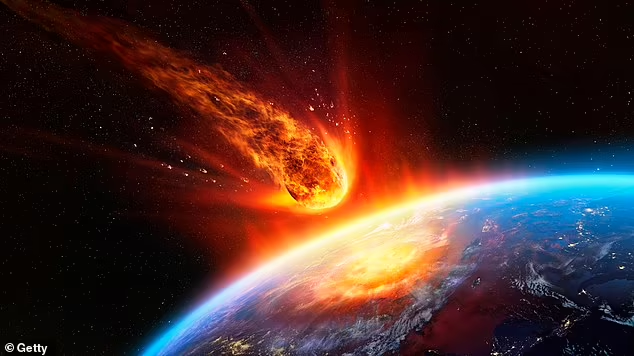Scientists have released a chilling new update on the so-called ‘city-destroying’ asteroid expected to make a dangerously close approach to Earth in 2032.
Although NASA has confirmed that asteroid 2024 YR4 poses no threat to our planet, recent observations from the James Webb Space Telescope reveal the Moon might not be so lucky.
Experts now estimate there’s nearly a 4% chance that the building-sized asteroid could collide with the lunar surface.
New data reveals the asteroid is even larger than scientists first believed.
Initial estimates from ground-based observations suggested that asteroid 2024 YR4 measured about 40 meters (131 feet) across. But updated measurements from space now put its diameter at a staggering 60 meters (200 feet) — roughly the height of a 15-story building.
If an object of that size were to strike Earth, it could release an explosion over 500 times more powerful than the atomic bomb dropped on Hiroshima.
Discovered in December last year, 2024 YR4 quickly raised alarm bells, with its estimated impact probability climbing to a record-breaking 3.1% — the highest ever recorded for a large asteroid.

Using the James Webb Space Telescope (JWST), scientists directly measured the size of 2024 YR4 and found that it has a diameter of 60 metres (200ft)
Back in February, space agencies around the world raised the alarm over asteroid 2024 YR4, warning of a serious risk it could strike Earth on December 22, 2032.
While most scientists anticipated that the odds of impact would decrease as predictions improved, the initial uncertainty was concerning enough to prompt urgent action.
In response, NASA made the rare decision to grant an international team of astronomers emergency access to the James Webb Space Telescope (JWST). Their mission: to precisely measure the size of the asteroid and assess the potential damage it could cause.
Previous estimates from ground-based telescopes were based on how much sunlight the asteroid reflected—an approach that can be unreliable. As the European Space Agency noted, a brighter appearance often suggests a larger object, but that brightness heavily depends on the reflectivity of the asteroid’s surface.
To get a more accurate reading, the JWST used its advanced infrared instruments to detect the heat radiating from the asteroid instead. This allowed scientists to directly measure its size without relying solely on reflected light.
On March 26, the JWST tracked asteroid 2024 YR4 for five hours as it spun silently through space.

Unlike ground-based telescopes, the JWST uses an instrument which measures the heat radiating from the asteroid in the form of infrared radiation (pictured). This allows scientists to work out exactly how large the asteroid really is

The chances of 2024 YR4, seen here by the European Southern Observatory on February 25, hitting Earth remain at zero. However, there is still a slim possibility that it could hit the moon
Infrared data collected during the five-hour observation revealed that asteroid 2024 YR4 measures approximately 60 meters in diameter, with a margin of error of about seven meters. It also rotates rapidly, completing a full spin every 20 minutes.
Had the asteroid still been on a collision course with Earth, its size alone would have been enough to trigger intervention from the United Nations-backed Space Mission Planning Advisory Group. This international body is tasked with coordinating planetary defense strategies, including potential asteroid deflection missions.
Dr. Andy Rivkin, an astronomer at Johns Hopkins University and lead investigator on the JWST emergency observation program, says the new data has dramatically improved our understanding of YR4.
“We found that the thermal properties of 2024 YR4—how quickly it heats up, cools down, and its current temperature at its distance from the Sun—differ significantly from those of larger asteroids,” he explained.
According to Dr. Rivkin, this unusual behavior is likely due to the asteroid’s rapid spin and a surface lacking in fine-grained dust. “It seems to be covered in rocks about the size of a fist or larger,” he added. “We’ll need more data to confirm, but that’s the picture emerging so far.”
Although the threat to Earth has now been ruled out, the episode serves as a crucial reminder: mastering the ability to detect and study near-Earth objects is essential for protecting our planet in the future.

This image shows the orbit of asteroid 2024 YR4 in purple with the sun in the centre and orbits of planets (Mercury = cyan; Venus = yellow; Earth = dark blue; Mars = red). On its current predicted path, there is a two per cent chance that the asteroid will hit the moon

If 2024 YR4, seen here from the Magdalena Ridge Telescope on January 18, does hit the moon it would be good news for scientists. The blast wouldn’t affect Earth but would allow astronomers to see a crater forming in real time
Dr. Rivkin notes, “As more advanced asteroid detection programs come online in the coming years, we expect to identify even more potential impact threats. That’s why observations with the most powerful telescope currently available are absolutely invaluable.”
“Learning how to make the most of the James Webb Space Telescope’s capabilities is something we can start doing right now with 2024 YR4,” Dr. Rivkin adds.
If the asteroid does strike the Moon in 2032, having precise knowledge of its size and composition could be a huge scientific opportunity. While the impact wouldn’t pose any danger to Earth, it would mark the first time scientists could observe a known asteroid creating a lunar crater in real time.
Such an event could provide valuable insights into the formation of other craters across the Moon’s surface and deepen our understanding of how these impacts shape celestial bodies.



